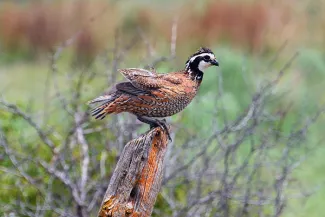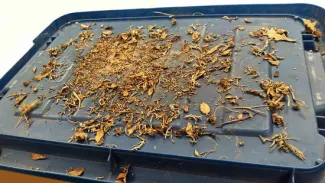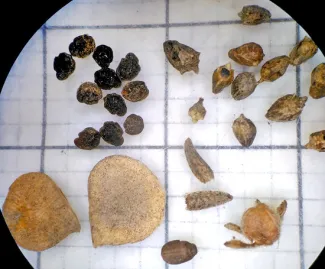
Figure 1. Probability of survival until end of March for daily cohorts of radio-marked bobwhite at Beaver River Wildlife Management Area. Based on data from 641 individual bobwhites across from 2012-17. Number of birds in daily cohorts (across years) varied continuously as birds died and new birds were fitted with radio collars (range: 88–370).
UPLAND UPDATE
QUAIL ECOLOGY AND MANAGEMENT PROJECT REPORT FOR JANUARY 2022
Provided by Oklahoma Cooperative Fish and Wildlife Research Unit, Oklahoma State University
Field work has ended for all components of the project.
Researcher Jennifer Knutson is preparing an Extension fact sheet on the relationship between woody vegetation (i.e., shrubs and trees of different heights) and the bird communities across Beaver River, Cross Timbers, Packsaddle, and Sandy Sanders Wildlife Management Areas.
Analyses estimating the probability of survival until the onset of breeding for daily cohorts of bobwhite at Packsaddle and Beaver River WMAs are ongoing. Preliminary results from Beaver River indicate that the average bobwhite at Beaver River has a 25 percent chance of surviving from the first week of quail hunting season until April, while the equivalent survival chance is 59 percent from the last week of the hunting season (Figure 1).
Thus, late-season harvest is potentially twice as impactful as early-season harvest. Work on additional analyses and summaries for the final report are ongoing, as is the writing of the report itself.
INVERTEBRATE WORK: Researcher Jacob Reeves began training an undergraduate student to sort and identify ant genera from pitfall trap samples collected at Packsaddle WMA during May-June 2021. Reeves is writing his dissertation proposal, which will combine data on arthropod abundance measurements on the ground with remote sensing data of vegetation at Packsaddle WMA. He also continued working on a review of the nutritional ecology of avian insectivores and analyses for a manuscript on variation in amino acid content of terrestrial arthropods.
Additionally, Reeves is working on sorting and identifying seed samples collected in January 2021 and made progress toward creating a reference collection. While sorting seeds out of collected plant litter and sand is quite tedious (Figure 2), identifying sorted seeds has been quite informative.
Figure 3 shows a selection of seeds collected from one 100-meter transect sample. In this sample, western ragweed was the most abundant seed, followed by buffalo burr. But there were several other plant species present, including prairie sunflower.
Sunflower seeds are highly sought-after during fall and winter, and it is unsurprising that these seeds would be less abundant than other typical winter foods. However, western ragweed is an extremely important source of nutrition during harsh winter months, and bobwhites are known to consume both the seeds and live plant tissue.
(This project is funded in by the Oklahoma Department of Wildlife Conservation, Federal Aid Project F18AF001-10: Quail Ecology and Management II.)

Figure 2. Initial seed sample processing. Plant litter and sand must be sorted out of samples to find and identify seeds.

Figure 3. A selection of seeds collected from one 100-meter transect sample. Top right quadrant: western ragweed (Ambrosia psilostachya). Top left quadrant: buffalo burr (Solanum rostratum). Bottom left quadrant: Palmer's spectaclepod (Dimorphocarpa canadicans). Bottom right quadrant: prairie sunflower (Helianthus petiolaris; elongated seeds) and others.